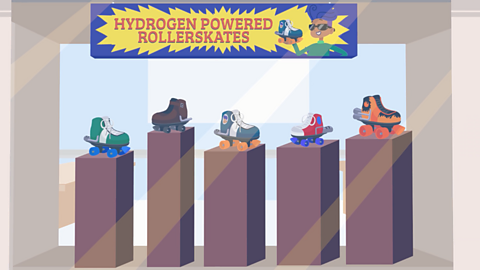What are settlements?
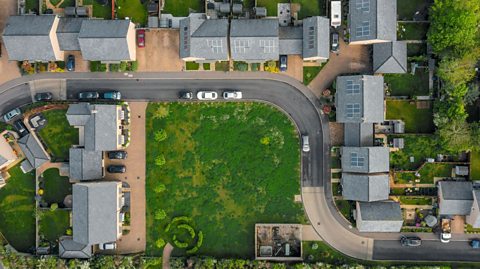
Settlements are places where people live and sometimes work.
They can be small or large depending on how many people live there and how many facilities there are.
Facilities are places where certain things happen.
For example, schools for education, parks for playing or shops for selling things.

Watch: Settlements
High up in my airship I can look down and see where people have built places to live and work, from hamlets and villages to towns and cities.
We call these places settlements.
But how can we tell the difference between a hamlet and a village? Or a town and a city?
Well, it mostly depends on how many people live in a place, and how many facilities like shops and schools there are.
Let me show you! This is a hamlet, which is a very small group of homes.
And this is a village. There’s a few shops, a post office, a village hall, as well as a primary school and a doctor’s office.
This is a town. There are more buildings, and there’s a railway station, a secondary school and a shopping centre.
And this is a city. There are lots of buildings and people.
There’s a cathedral, a sports stadium, and large buildings such as universities and hospitals.
Strangely, if a settlement has a cathedral, it’s also called a city, even if it’s not very big, like St Davids in South Wales.
Some settlements have a particular function. For example, this is a port where ships bring goods to and from the UK.
And this is a market town, where local farmers and traders buy and sell their produce.
It all looks so busy down there. I think I prefer it up here.
Types of settlements
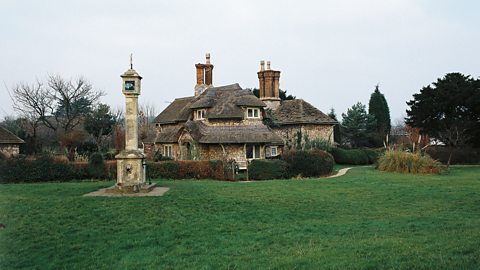
- A hamlet is a very small settlement with just a group of houses.

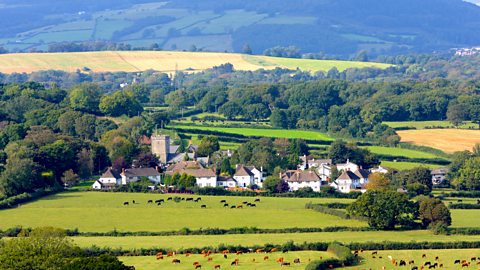
- A village is also small but may have houses, a primary school, a few shops, a Post Office and a village hall.
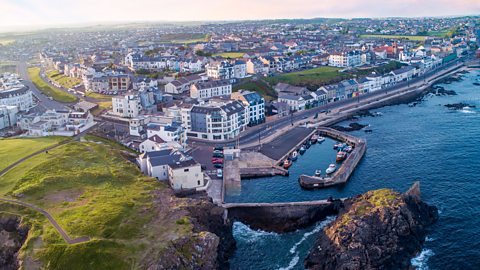
- A town is larger than a village, with lots of houses, primary and secondary schools, as well as sometimes having a railway station and shopping centre.

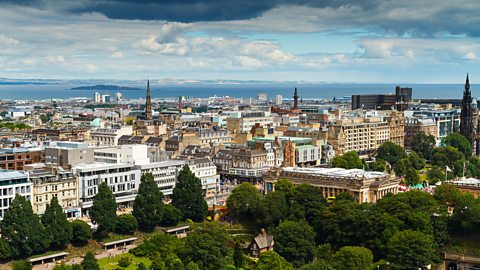
- A city is the largest type of settlement, containing lots of buildings and lots of people. They usually have hospitals, sports facilities, universities, shops, offices, many houses and often a cathedral.
- In the UK however, some cities may be small. This is because some settlements have a cathedral and this makes them a city. For example, St Davids in Wales and Wells in England.
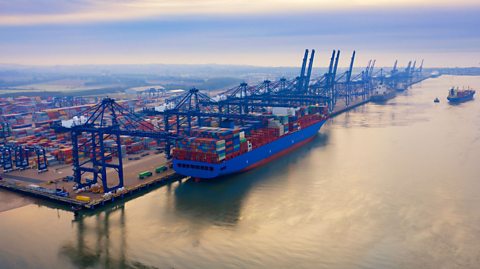
Some settlements also have a special use, or function. For example:
- ports - by a river or sea for ships to transport goods
- market towns - where local farmers sell goods
- resorts - where people go on holiday

Watch: Exploring cities
Birmingham is the UK’s second largest city after London, the UK’s capital. It is in an area of England called the Midlands.
Cities are known for trade and economic activity. Cities usually have tall high-rise buildings for people to work in and lots of people who live in flats in cities.
Learn more about cities in this video from BBC Teach.
De-Graft: This is Birmingham, the second largest city in the UK after London, which is the UK’s capital city. And I’m about to get a real good zoomed in look at it.
A city is a large type of settlement. There’s no one definition of what a city is - it can be related to size, function, or even the presence of a cathedral.
Birmingham is one of 69 cities across the UK and later locals Alanna and Willow will be taking in the city's views with me. But first, let’s zoom out…
Birmingham is in an area of England called the Midlands. There are 51 cities in England, seven in Scotland, six in Wales, and five in Northern Ireland. If you look at satellite images that show the activity of the UK at night you can spot the locations of major cities from the patches of lights.
Each of the four countries that make up the UK have a capital city, where the government of that country is based and some of the country's most iconic buildings can be found. London is the capital city of England. Edinburgh is the capital city of Scotland. Belfast is the capital city of Northern Ireland. And Cardiff is the capital city of Wales.
Lots of people work in cities. Cities are known for trade and economic activity. You’ll often find tall high-rise buildings used as offices for people to work in. Such as in Hong Kong or Manhattan in New York, which are areas with extremely high population density. Not all of the high-rises are offices as lots of people also live in cities, often in flats.
Some people move to the outskirts of a city, called the suburbs, where there’s more space. People have different opinions on cities… Some people don’t like the city because it’s too bustly and noisy, whereas other people like the fact that there’s access to lots of things in one place. Cities often have many tourist attractions and are hubs of entertainment with places like museums and galleries.
Birmingham has the largest public library in the UK and I’m meeting locals Alanna and Willow on its rooftop garden to get a good view over the city.
Hey guys, what are you up to?
Willow: We are drawing a skyline of Birmingham and the buildings.
De-Graft: Now Willow, I know you want to be an architect when you’re older, what kind of buildings would you design?
Willow: It would be a social club for kids and it would be shaped as a square.
De-Graft: Well we know with cities, there can be a lot of construction. Construction could mean the removal of green spaces or natural habitats. But as well as construction, we can have areas of high congestion. Now, congestion is when we have lots of traffic on the roads and fumes being pumped out into the atmosphere. Now we know that those fumes can be very harmful to the environment and can cause pollution. But there are ways of reducing congestion. Do you know any?
Alanna: You could use public transport.
Willow: If you were going to school and you lived close, you wouldn’t have to go in your car. You could just walk or cycle.
De-Graft: Yeah, you guys are right. And some cities have initiatives like clean air zones, which encourage people to use public transport instead of using their own cars.
Do you guys have any other ideas of how we could look after our cities?
Alanna: For some people who are in wheelchairs like me, I would say get rid of most of the trash, so it’s not so bumpy and stuff.
Willow: We could just recycle. If we have a plastic bottle or a plastic jug or something, we could recycle it or keep using it again for different things.
De-Graft: OK, time to compare… The population of London, nearly nine million people, is 100 times the size of a full Wembley Stadium. The largest city in the world is Tokyo in Japan, it is often referred to as a ‘megacity’ as the urban area spreads out so far. It covers over four times the area of London and is home to around 38 million people, that’s more than half of the entire population of the UK!
If you could design a city what would it look like? How would people get around, would it be environmentally friendly? Would you even allow cars? Zoom in and have a go for yourself.
So which one of you two is going to teach me how to sketch?
Activity: Quiz – Settlements
SATs preparation resources. activitySATs preparation resources
Get ready for the SATs papers with videos, activities, quizzes and games to refresh your knowledge and practise your skills.

More on Economy and trade
Find out more by working through a topic
- count3 of 4
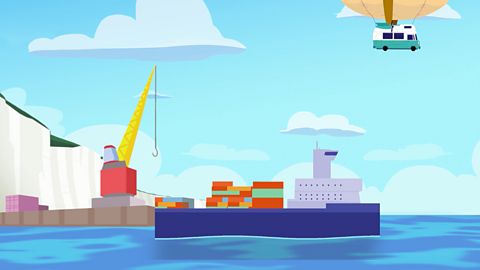
- count4 of 4
